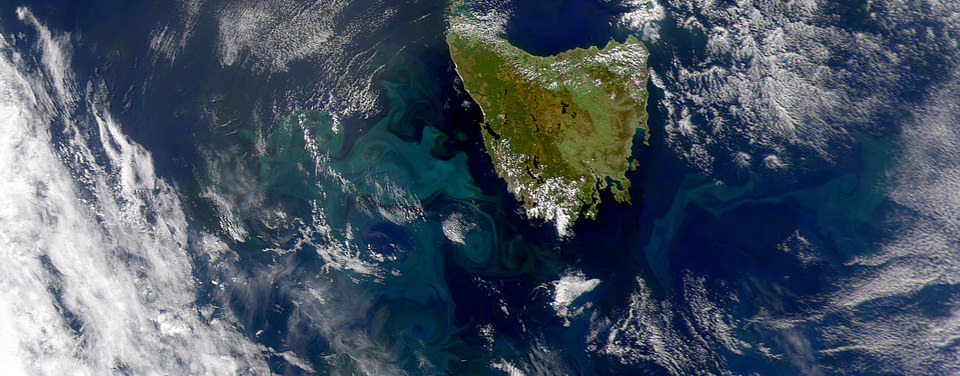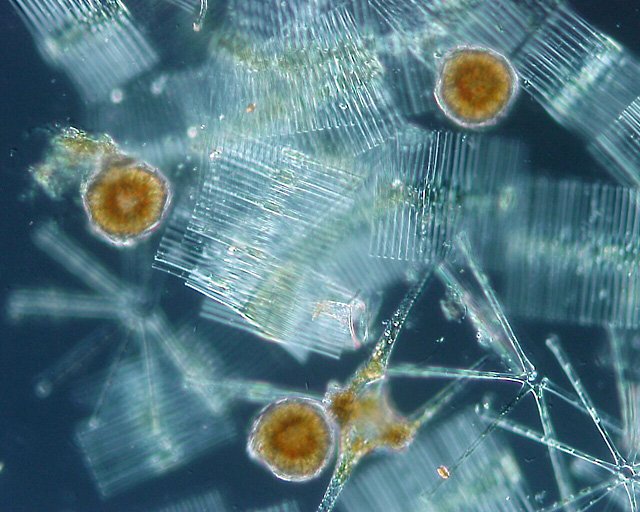
Can you spot the eddies? This NASA image shows a field of eddies in the waters around Tasmania. The swirling motion of eddies in the ocean cause nutrients that are normally found in colder, deeper waters to come to the surface. Here, phytoplankton (tiny ocean plants) feeding on these nutrients color the water beautiful shades of blue and green. Image: National Oceanic and Atmospheric Administration
“Can you spot the eddies? This NASA image shows a field of eddies in the waters around Tasmania. The swirling motion of eddies in the ocean cause nutrients that are normally found in colder, deeper waters to come to the surface. Here, phytoplankton (tiny ocean plants) feeding on these nutrients color the water beautiful shades of blue and green.” Image: National Oceanic and Atmospheric Administration
What do the Sydney to Hobart Yacht Race and the Australian freshwater eel have in common? Every year, they head out of the confines of Sydney Harbour to the wild depths of the ocean on the ride of their lives.
The Australian freshwater eel migrates north, swimming from far up the rivers on the east coast of Australia, eventually out to the ocean where it heads to the Coral Sea. Once there, it spawns abundant, tiny translucent larvae, which then hatch and embark on the big commute back to their mothers’ home.
With distances up to 1500 km, it might sound like a very long way to go just to lay some eggs and raise your offspring – but for both parties (the Yacht crews ideally don’t produce spawn along the Bass Straight) the round-trip from their home to their destination and back again is made much easier, thanks to an ocean phenomenon called eddies.
We’re not talking about legendary AFL player Eddie Betts or even this home energy tool we developed – we’re talking about ocean whirlpools that play a stunningly important role in the ecosystem, transporting heat, nutrients, salt and marine animals (including humans) around the ocean.
Where do ocean eddies come from?
The ocean is pretty darn big, and because of the nature of shifting wind cycles, it’s constantly in motion. We call these general patterns of motion currents.
Australia’s major current systems include the East Australian Current in the east (made famous by some fishy friends hitching a ride in Finding Nemo), the Leeuwin Current in the west, and currents that connect the Pacific and Indian Oceans via the Indonesian Passages and in the Southern Ocean.
Eddies peel off from boundary currents, and form in energetic ‘bowls’, hundreds of metres deep and hundreds of kilometres wide. The strongest currents in the deep ocean are found at the outer edge of these eddies, like winds around the highs and lows in the atmosphere. Although the currents are strong, the eddies themselves are more like gentle giants slowly moving through ocean, taking months to travel from Sydney to Bass Strait.
Australia – home of the eddies
Australia is unusual because we have two strong boundary currents: the Leeuwin in the west and the East Australian Current in the east. And where there are strong ocean currents, there are eddies. The region of southern NSW has actually been nicknamed Eddy Ave because of all the eddies that form there.
For those crews sailing in the Sydney to Hobart Yacht race on Boxing Day, hitching a ride on an eddy can either slingshot them towards Hobart’s finish line, or push them back towards Sydney – depending on the direction of the rotation of the currents around the eddy.
But what’s so fascinating about eddies is that they’re associated with upwelling, which can bring key nutrients from the deep, dark waters up to the surface of the ocean.
Taking a sea change
An upwelling sounds quite ominous, but in reality, it’s like a big family holiday destination for marine life.
Our oceans are complex, inter-related communities of plants and animals. And when some eddies form, cold, nutrient-rich water can rise up from below to replace the surface water.
Just like stirring a big pot of soup where the really good stuff is hanging around on the bottom, upwelling renews the nutrient supplies of the top-level surface, kick-starting a renewal of the food supply, which benefits many organisms in turn.
How? It starts by the providing essential nutrients to phytoplankton (tiny ocean plants known as microalgae), which live near the surface. Phytoplankton provide a convenient food source full of fatty acids for many of the ocean’s invertebrates and fish species, including eel, yellow tail king fish, anchovy and dolphin.
Because upwelling can trigger an increase in phytoplankton production, eddies produce enhanced conditions for breeding, and so are associated with an increase in spawning activity for many larval species.
Spanning up to 50-200 km wide, eddies can sustain themselves anywhere from a number of weeks to a number of months, functioning as bustling oases for baby marine animals.

Eddies provide essential nutrients to phytoplankton. Image: Neon Ja
Eddies provide essential nutrients to phytoplankton. Image: Neon Ja
Our research
When our atmosphere system changes significantly so as to affect the development of eddies, it can in turn have dramatic effects on the ocean circulation, which can have a big effect on the ocean’s ecosystem, and as a result, our weather patterns.
One of the most useful tools for understanding eddies is the Argo fleet, which floats around the ocean measuring the temperature and salinity of the surface – up to 2 km in depth.
Over the past twenty years we have been able to observe eddies in the ocean with satellite altimeters and in that time we have seen some significant changes in the number of eddies coming south past the Bass Strait, down to Tasmania. At the same time, we’ve observed that the temperature on the east coast of Tasmania has been warming. In 2015/16, a marine heat wave took place, which has impacted on the health of Tasmania’s kelp forests.
So, whether it’s about finding the most strategic route down to Hobart, or looking for the best fishing grounds, it’s important that we study ocean currents and eddies in order to sustainably manage our marine resources and understand how the global ocean circulation is likely to change over the decades to come.


8th December 2017 at 6:45 am
Wow this is really great “stuff” Good work CSIRO this opened my eyes to a few things I never realised.
6th December 2017 at 3:57 pm
Can the Argo fleet be modified to note the pings of a downed aircraft, triangulate and report its last known position?